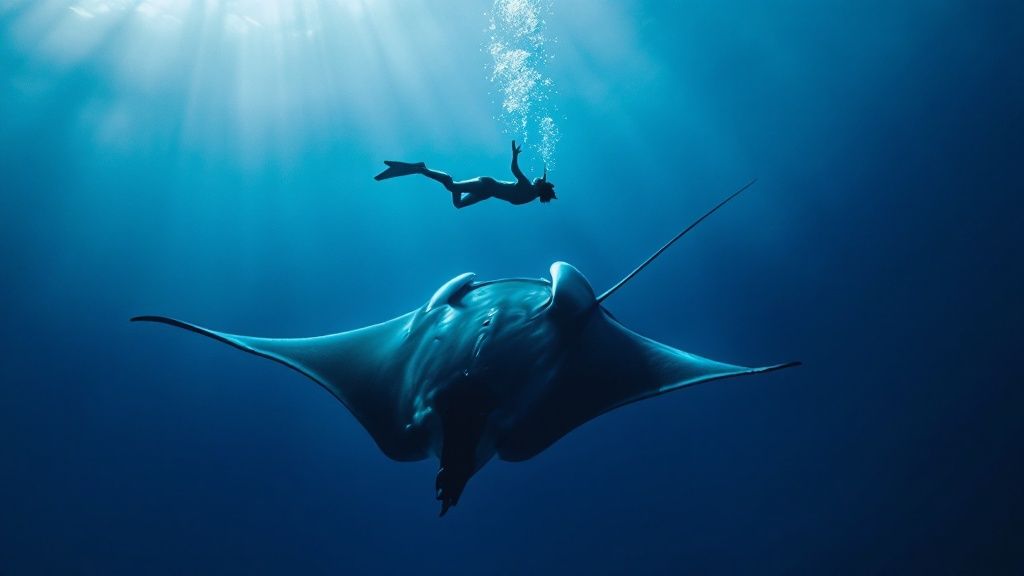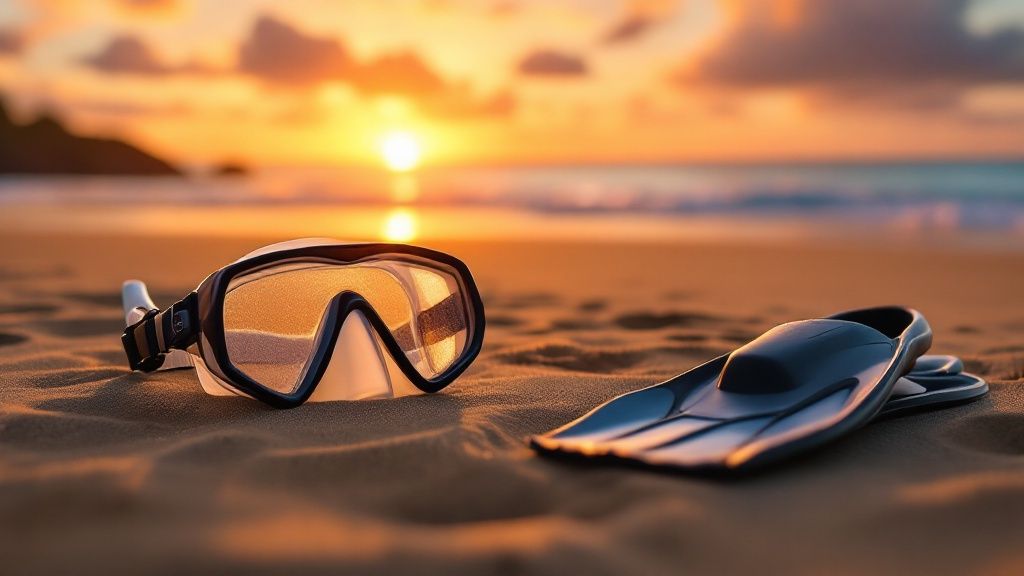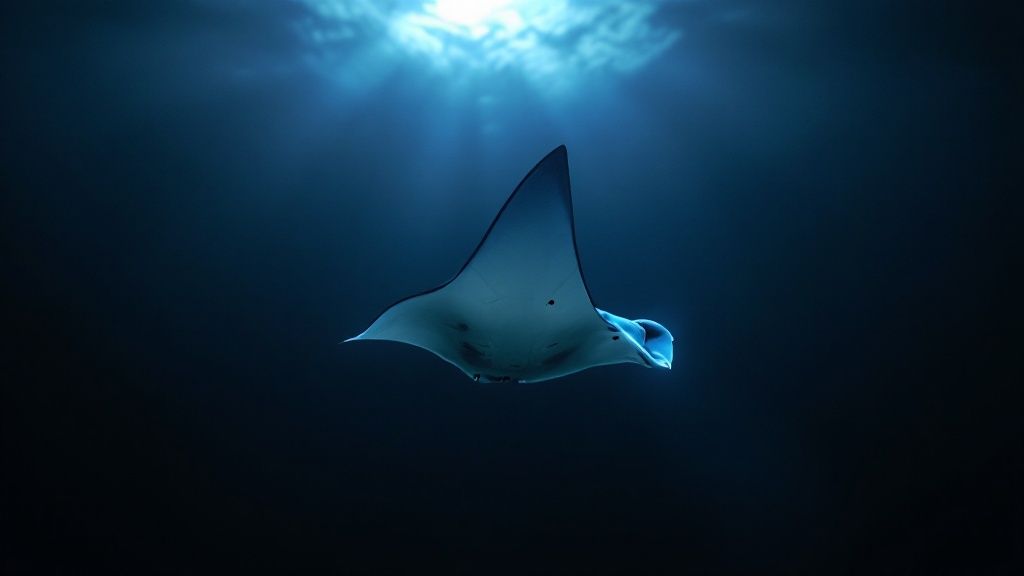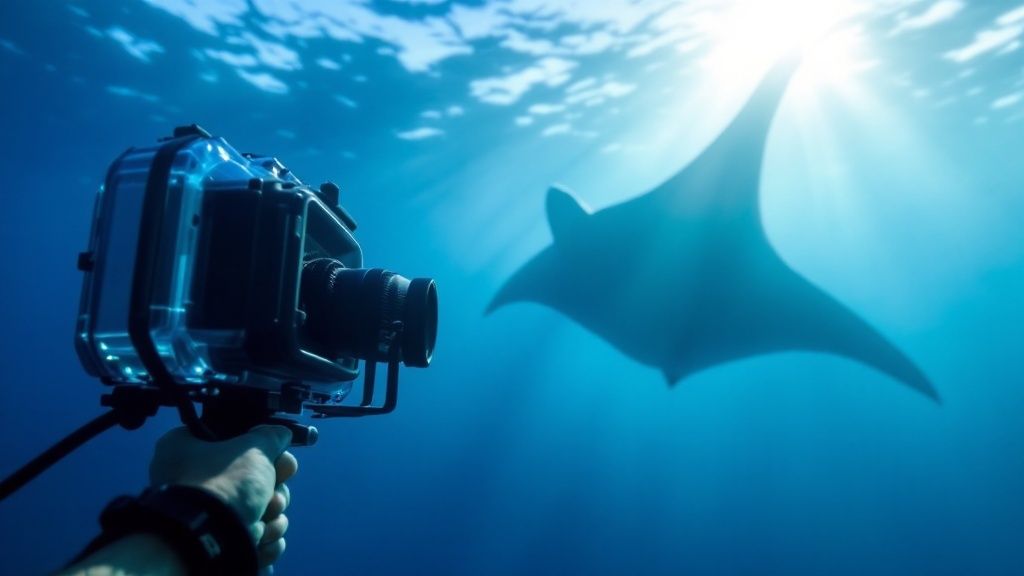Manta Ray Snorkel Kona | Experience Hawaii's Best Adventure
- Byron
- May 27
- 11 min read
Why Kona Rules The Manta Ray Snorkeling World
Kona, Hawaii, isn't just any snorkeling spot; it's a manta ray haven. The Big Island's volcanic coastline creates ideal conditions for these gentle giants. It's not just a story; science supports it. Volcanic rock provides shelter and cleaning stations. Nutrient-rich currents, stirred by volcanic activity, bring plankton blooms, a manta ray's main food source. This makes Kona a hotspot for manta ray activity.
Understanding Kona's Underwater Topography
The underwater topography is key. Volcanic slopes push nutrient-rich water up, creating plankton pockets. These become predictable feeding grounds for manta rays, making specific locations reliable viewing spots. Snorkeling tours can consistently bring guests to areas with high chances of manta ray encounters.
Kona's Thriving Manta Ray Population
Kona has over 450 identified manta rays. Each is cataloged, allowing researchers to track their movements, feeding habits, and health. This research is vital for understanding and protecting these creatures. Responsible tourism directly supports these conservation efforts. Kona is known for its high manta ray sighting success rate, with an 85-90% chance during night dives and snorkeling trips. This is due to nutrient-rich upwellings and favorable water conditions along the Kona Coast. Around 80,000 people enjoy manta ray snorkeling in Kona each year. Find more statistics here: Jack's Diving Locker Manta Ray Report
Why Kona Outperforms Other Destinations
Other places offer manta ray encounters, but Kona's feeding-focused interactions are special. While other destinations focus on cleaning stations, Kona lets you watch them feed. Imagine these graceful creatures performing an underwater ballet as they swoop and swirl to capture plankton under the lights. This dynamic feeding behavior makes Kona unique and a bucket-list destination for marine wildlife enthusiasts.
Finding The Best Manta Ray Snorkeling Spots In Kona
Not all snorkeling spots are created equal when it comes to manta ray encounters. Knowing where to go in Kona can significantly impact your experience. This section shares insider tips for truly amazing manta ray snorkeling adventures.
Manta Village: The Perfect Spot for Beginners
Manta Village, south of Kona off Keauhou Bay, is renowned as the spot for beginners. Its shallow, sandy bottom makes it easy to navigate, especially for those new to snorkeling. This allows you to focus on the manta rays, not the water conditions. The shallow depth also provides excellent visibility, offering incredible up-close views.
Manta Heaven: A Deeper Dive for Experienced Snorkelers
For experienced snorkelers seeking deeper water and more dynamic encounters, Manta Heaven (also known as Garden Eel Cove) is ideal. Located north of Kona, it’s a feeding hotspot under certain conditions. While Manta Village has more reliable sightings, Manta Heaven offers the potential for larger groups of feeding manta rays, creating a breathtaking spectacle. You might be interested in: Our guide to the best times to see manta rays.
Hidden Gems: Exploring Kona's Less-Crowded Spots
Beyond the popular spots, Kona offers hidden gems. These less-crowded locations provide a more intimate experience. While they require a little more research, experienced snorkelers appreciate the unique encounters these spots offer. The area near the Kohala Coast Resorts, for example, offers a similar manta ray viewing experience with fewer crowds.
Choosing the Right Snorkeling Spot
Choosing the right spot depends on your skill level, the time of year, and the type of encounter you're looking for. Kona's high manta ray sighting frequency is closely linked to its geological features. The volcanic underwater terrain creates nutrient-rich upwellings attracting plankton, the manta rays' primary food source. Manta Village, with its shallow sandy bottom, is ideal for all skill levels, while Manta Heaven offers deeper waters and a diverse feeding ground. Explore this topic further. Understanding these factors helps you choose the perfect spot for a remarkable snorkeling experience. Read also: Understanding seasonal changes and their impact on viewing conditions.
To help you choose the best location, we've compiled a comparison table highlighting key features of each spot:
Kona Manta Ray Snorkeling Locations Comparison
Detailed comparison of the top manta ray snorkeling spots in Kona, including depth, skill level requirements, and best conditions
Location | Depth Range | Skill Level | Best Time | Unique Features |
|---|---|---|---|---|
Manta Village | 10-20 ft | Beginner | Year-round | Shallow, sandy bottom, excellent visibility |
Manta Heaven | 30-40 ft | Intermediate/Advanced | Evening/Night | Deeper water, potential for larger feeding groups |
Kohala Coast Resorts | 20-30 ft | Intermediate | Year-round | Less crowded, similar experience to Manta Village |
This table provides a quick overview of the key differences between the locations, allowing you to make an informed decision based on your experience and preferences. Remember to always check current conditions and follow safety guidelines before entering the water.

What Actually Happens During Your Manta Ray Adventure
Forget the glossy brochures. Let's get real about what a manta ray snorkel adventure in Kona is actually like. From the moment you board the boat to that first incredible manta ray encounter, here's a step-by-step guide of what you can expect.
Embarking on Your Manta Ray Journey
Most tours depart from Honokohau Harbor in Kona. Once aboard, you'll enjoy a scenic boat ride to one of Kona's prime manta ray viewing locations, such as Manta Village or Manta Heaven. During the trip, your guides will fill you in on manta ray biology and behavior, important safety procedures, and proper snorkeling etiquette. This ensures a respectful and rewarding experience for both you and these magnificent creatures.

The Night Snorkeling Setup
Once you arrive at the snorkel site, the real adventure begins. The nighttime setting is key. Under the cover of darkness, bright underwater lights are placed in the water. These lights attract plankton, a manta ray's main food source, creating a captivating glow. Snorkelers usually hold onto a flotation device with lights attached. This provides stability and a perfect viewing spot as the manta rays start their feeding ritual below. To learn more, check out our article: Why manta ray night snorkeling is the ultimate Kona adventure.
Witnessing the Manta Ray Feeding Frenzy
As the plankton swarm around the lights, the manta rays appear, often in groups. You’ll be amazed by their graceful movements as they glide and circle through the illuminated water, filtering plankton with their huge cephalic fins. These gentle giants can get incredibly close, sometimes mere inches away, giving you an up-close and personal experience you'll never forget. The underwater lights enhance the whole spectacle, creating an otherworldly ambiance that highlights the manta rays' elegant dance.
Managing Expectations and Safety
While Kona has high manta ray sighting rates (around 90%), remember that nature is unpredictable. If conditions aren't ideal, your guides may suggest other viewing spots or reschedule your tour. Safety is a top priority in the open ocean, and the experienced guides are committed to your well-being. They’ll give you clear instructions on how to interact respectfully with the manta rays and navigate the night snorkeling environment, ensuring a safe and memorable experience for everyone.
Getting Ready For Your Manta Ray Encounter
Success on a Kona manta ray snorkeling trip begins long before you enter the water. Proper preparation can transform a potentially challenging experience into a truly magical encounter. This section outlines the key steps to get ready for your manta ray adventure.
Physical and Mental Preparation
While you don't need to be a champion swimmer, a reasonable level of comfort in the water is essential. You'll be snorkeling in the open ocean at night, so being able to float and tread water with ease is key. If you need a refresher, consider practicing in a pool before your trip to boost your confidence. Mental preparation is also important. Visualizing the experience and practicing slow, deep breathing can help you stay calm and present in the open ocean at night.
Gear Up for the Encounter
The right gear plays a vital role in a comfortable and successful manta ray snorkel. Most tour operators provide basic equipment such as masks, snorkels, and fins. However, bringing your own wetsuit is often a good idea. Kona’s waters can get chilly after sunset, particularly during the winter. A 3mm wetsuit is usually adequate for summer, while a 5mm wetsuit provides more warmth from November to March. Don't forget water shoes to protect your feet on the boat and during entry and exit! For those wanting to capture the magic, a GoPro or other waterproof camera with low-light capabilities is highly recommended. Remember to test it thoroughly beforehand.
Seasickness and Other Considerations
If you're prone to seasickness, taking precautions is essential. Over-the-counter medications like Dramamine or motion sickness patches can be helpful. Consult your doctor for personalized advice. Packing a towel and a change of dry clothes is also wise. Familiarizing yourself with basic underwater hand signals can improve communication with your guides and fellow snorkelers, especially at night. For more tips, check out this helpful resource: 10 Manta Ray Snorkel Tips.
Managing Expectations: Nature’s Unpredictability
While Kona boasts an impressive manta ray sighting rate of around 90%, it's crucial to remember that these are wild animals in their natural habitat. Nature is unpredictable. Your guides might suggest alternative viewing locations or even reschedule your tour if conditions aren't optimal. Trust their expertise and be flexible. They're dedicated to providing you with the best possible experience while prioritizing everyone's safety. Maintaining a positive attitude and embracing the unexpected will ensure you enjoy the adventure, no matter the conditions.
Protecting Manta Rays Through Responsible Tourism
Experiencing the magic of manta rays in their natural habitat is an unforgettable adventure. But these incredible encounters come with a responsibility to protect these gentle giants and their environment. Thankfully, manta ray snorkel experiences in Kona, Hawaii are built on a foundation of sustainable tourism practices. This commitment to conservation adds another layer of meaning to the entire experience.
Understanding the Regulations
Manta ray interactions in Kona are carefully managed. Strict protocols are in place to safeguard both the manta rays and the snorkelers who come to see them. For instance, distance protocols prevent snorkelers from getting too close and possibly disrupting the manta rays' feeding. Touching the manta rays is absolutely forbidden, as it can harm their delicate mucous layer, which is vital for their immune system. Trained guides enforce these guidelines, prioritizing both safety and responsible interaction.
Sustainable Practices: A Win-Win
Manta ray snorkeling in Kona is a highly popular activity, and its regulations emphasize responsible tourism. The impressive 80-90% sighting success rate speaks volumes about the health of the local environment and the diligence of tour operators. They work hard to ensure these encounters are safe for participants and sustainable for the manta ray population. Find more detailed statistics here. This success clearly shows how responsible tourism can benefit both the local economy and the environment.
The Power of Your Choice
Choosing the right tour operator plays a significant role in the success of manta ray conservation efforts. Many operators actively participate in research initiatives and provide financial support to manta ray protection programs. By selecting an operator dedicated to these principles, you directly contribute to the long-term sustainability of these incredible experiences. Responsible tourism not only allows us to witness the beauty of these creatures, but also plays a critical role in ensuring their survival for generations to come.

Kona: A Global Model
Kona's approach to manta ray tourism serves as an example for other destinations around the world. Its success demonstrates the effectiveness of balancing accessibility and protection. Through cooperation between tour operators, researchers, and conservationists, Kona has created a sustainable ecosystem. This ecosystem prioritizes the well-being of these magnificent creatures while still allowing us to experience their wonder. This careful approach ensures the continuation of manta ray encounters and the overall health of the marine environment. These programs aren't just about showcasing the ocean's beauty to tourists; they are about safeguarding that beauty for the future.
Choosing Tour Operators That Actually Deliver
Planning a manta ray snorkel tour in Kona? Not all tours are the same. The tour operator you select significantly impacts your overall experience, making the right choice essential for an unforgettable adventure. This section helps you understand the key factors that distinguish exceptional tour operators from mediocre ones.
Key Factors to Consider
What makes a manta ray snorkel tour truly special? Here's what sets the best Kona operators apart:
Safety Track Record: Safety is paramount. Prioritize operators with lifeguard-certified guides and established safety protocols, including proper onboard equipment and clear emergency procedures.
Group Size: Smaller groups generally offer more personalized attention and closer manta ray interactions. Carefully consider the group size when making your decision.
Guide Expertise: Knowledgeable guides enrich the experience by providing insightful information about manta ray behavior and the local ecosystem. Their expertise deepens your appreciation for these creatures.
Evaluating Tour Formats and Pricing
Tour formats vary. Some cater to smaller, intimate groups, while others accommodate larger numbers. Think about which atmosphere you prefer. It’s also important to understand how pricing reflects true value. Some operators offer extra amenities, like professional photography or refreshments, that might justify a higher price tag.
Questions to Ask and Red Flags
Here are some crucial questions to ask potential operators:
What is their experience and history operating in Kona?
What is their manta ray sighting success rate?
Do they adhere to sustainable tourism practices?
What is their cancellation policy?
What's included in the tour price (e.g., equipment, wetsuits)?
Be cautious of operators who avoid these questions or make unrealistic promises. Unusually low prices can also be a red flag, potentially indicating compromised safety or quality.
Conservation Contributions
Consider supporting operators dedicated to conservation. Choosing a tour operator who actively participates in manta ray research and protection programs helps safeguard these magnificent animals.
Insider Tips for Booking
When booking, consider the season. Kona's waters are calmer and offer better visibility during the summer months (April–October), creating ideal snorkeling conditions. During winter (November–March), increased winds and rougher seas can lead to cancellations.
To help you make the best choice, we've compiled a table summarizing key selection criteria:
Before we dive into the details, here's a quick overview of the factors to consider when selecting your manta ray tour operator. This table will help you make an informed decision and ensure an unforgettable snorkeling experience.
Manta Ray Tour Operator Selection Criteria
Criteria | Why Important | Questions to Ask | Red Flags |
|---|---|---|---|
Safety | Protects you and the manta rays | What safety certifications do the guides have? What are the emergency procedures? | Lack of clear safety protocols or vague answers |
Group Size | Impacts the quality of the experience | What is the maximum group size? | Excessively large groups |
Guide Expertise | Enhances understanding of manta rays and the environment | How experienced are the guides? What kind of information do they share? | Guides who seem uninformed or lack enthusiasm |
Conservation | Supports manta ray protection | Do you contribute to research or conservation efforts? | Lack of interest or involvement in conservation efforts |
Price | Reflects value and what’s included | What is included in the price? | Unusually low prices that seem too good to be true |
This table provides a framework for evaluating different tour operators. Use it as a guide to ask the right questions and identify potential red flags.
By considering these factors and conducting thorough research, you can choose a manta ray snorkel Kona tour operator that will provide a truly exceptional and memorable experience.
Key Takeaways For Your Manta Ray Adventure

Planning a manta ray snorkel trip in Kona? This guide offers practical advice and realistic expectations for an unforgettable experience, covering everything from pre-trip planning to maximizing your encounter.
Planning and Booking Your Adventure
Timing is key for optimal viewing conditions. While Kona's manta rays are present year-round, the best time to visit is typically between April and October. These months generally offer calmer waters and increased visibility, perfect for snorkeling.
Choosing the right tour operator is crucial for a positive experience. Look for operators with a strong safety record, smaller group sizes for a more personalized touch, and a commitment to sustainable tourism. Don't hesitate to ask about their experience, manta ray sighting success rate, and conservation efforts.
Manta ray snorkel tours in Kona are popular, particularly during peak season. Booking in advance is highly recommended to secure your spot and avoid disappointment.
Preparing For Your Encounter
Proper gear can enhance your comfort and enjoyment. While operators provide basic snorkeling equipment, consider bringing your own wetsuit. A 3mm wetsuit is usually sufficient for summer, while a 5mm wetsuit is better suited for winter conditions. Water shoes are also a good idea. And don't forget an underwater camera with low-light capabilities to capture the incredible sights!
If you are prone to seasickness, take precautions by preparing over-the-counter remedies or consulting your doctor before your trip.
Mental preparation can also help ensure a comfortable experience. Visualizing the encounter and practicing deep breathing techniques can help you stay calm and present in the open ocean at night.
Maximizing Your Manta Ray Experience
Respecting these gentle giants is paramount. Maintain a safe distance from the manta rays, avoid touching them, and refrain from using flash photography. Always listen to your guide's instructions for responsible interaction.
For optimal photography, adjust your camera settings for low-light conditions and consider using a red filter to enhance colors. Patience and observation are key to capturing stunning images.
While Kona has a high manta ray sighting rate (around 90%), remember that nature is unpredictable. Be flexible and trust your guide’s expertise, even if conditions aren't perfect.
Extending Your Marine Education
After your tour, consider visiting the Manta Learning Center at the Sheraton Kona Resort to learn more about manta ray biology and conservation.
Your manta ray snorkel adventure in Kona is a unique opportunity. By following these tips, you'll be well-prepared for an unforgettable experience in Kona's beautiful waters. Ready to book your adventure? Check out Manta Ray Night Snorkel Hawaii for an exceptional and sustainable tour experience.
Comments